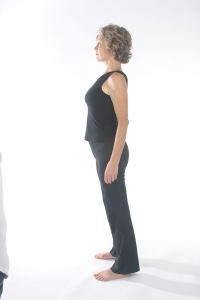This is the first of a series of several stories about people who have come to me in pain, and, through learning to relax their chronically tight muscles, have told me that they literally feel as if “they have their life back.”
“Sarah”
 This photo shows a slim, athletic body that looks to have almost perfect posture. Look closer, though, and see how her back is arched in a C-shape. Tight muscles have arched her back and over time created stiff, painful back muscles all along the back of her body.
This photo shows a slim, athletic body that looks to have almost perfect posture. Look closer, though, and see how her back is arched in a C-shape. Tight muscles have arched her back and over time created stiff, painful back muscles all along the back of her body.
“I just feel old,” Sarah told me when she came to my office for a consultation. “I don’t know what it is. Maybe it’s my age, but I don’t think so. I used to be able to run, take yoga class, and work out, but now everything just hurts. I even used to ski and now I can’t even do that! I mean, I’m only 46, but I feel like I’m 80.”
Her doctor told her that she might have arthritis due to her age, but that there’s nothing wrong with her. He suggested she slow down and rest, and that “might feel better with time.” Sarah was thin, healthy and very athletic, but with chronic back pain. She was not only tired, but scare d. She couldn’t imagine her life without movement and exercise.
d. She couldn’t imagine her life without movement and exercise.
Green Light
After the very first session in which she learned how to relax the large muscles of her back, she said “she knew there was hope.” She learned that nothing was wrong with her; she had simply gotten stuck and created bad habits of sitting and standing which were causing her back pain. She had habituated to what Thomas Hanna called the Green Light Reflex.
This full body reflex instantly contracts the muscles of the back of the body any time there is a demand put on us and there is a need to get something done. It is a positive response to stress and allows us to run, walk, stand, or carry things. However, you don’t want to get stuck in this reflex pattern.
Movement that helps
At the end of her first session, I taught her the sitting exercise; she learned that the way in which she sat caused her back muscles to constantly contract. She was shocked to realize that for years she had been sitting with an overly arched lower back while all the time thinking that she was sitting up “straight.”
“I’ve been teaching my children to sit the same way. I’m very particular about their posture, and I always tell them to stand up straight. I can now see that I’m teaching them the wrong way to sit,” she confessed.
Sarah learned several easy, gentle Somatic Exercises, which, when done every day, helped her to remember what it feels like to both release and control her muscles. She told me, “I didn’t even know that I wasn’t relaxed until I started doing these exercises.” We did three more sessions, but I haven’t seen her in a while. However, I do hear from her personal trainer that she’s back to working out and feeling excellent!
To purchase my Pain-Free Somatic Exercise DVDs, visit the Essential Somatics® store.





